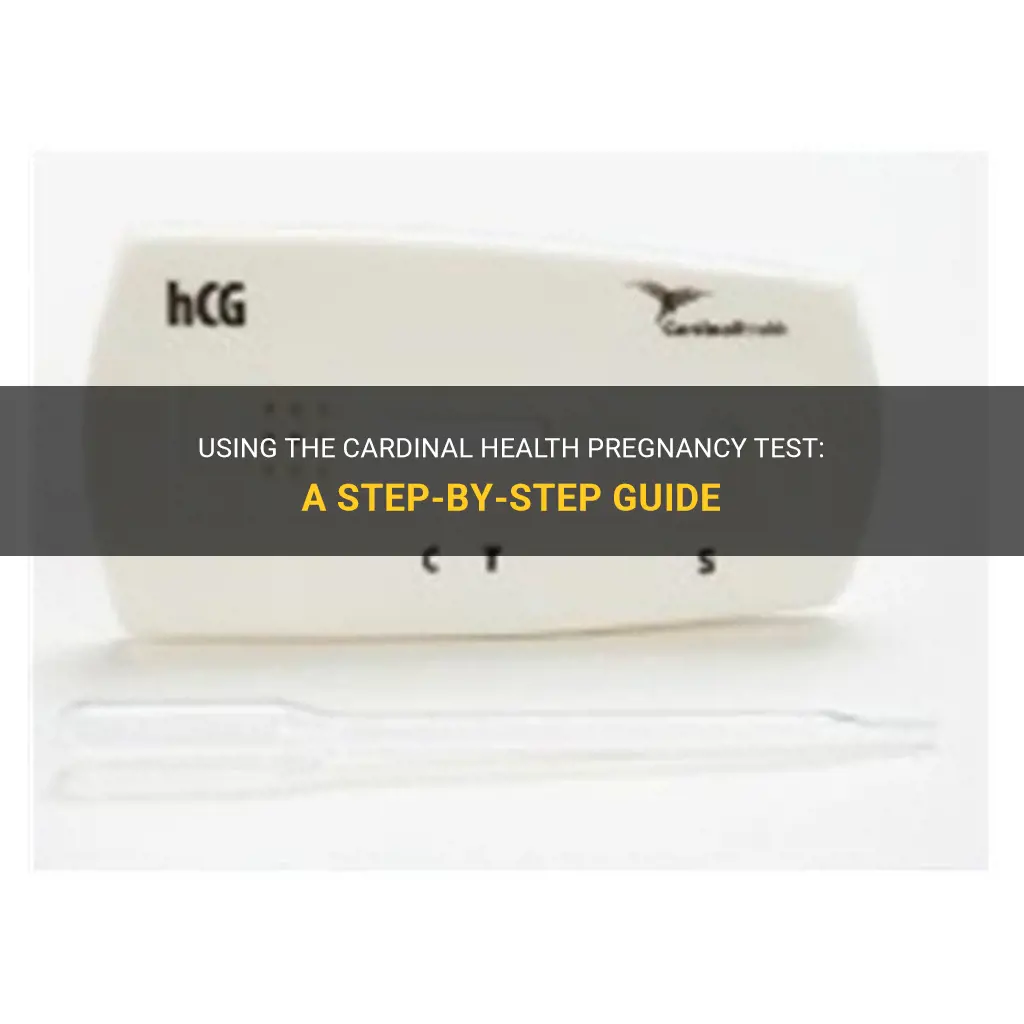
Are you curious about whether or not you are pregnant? Cardinal Health Pregnancy Test can help you find out! This easy-to-use pregnancy test is designed to provide accurate results in the comfort of your own home. By following a few simple steps, you can quickly and easily determine if you are expecting a little bundle of joy. Let's dive deeper into how to use the Cardinal Health Pregnancy Test and discover the simplicity it offers in providing you with the answer you're seeking!
| Characteristics | Values |
|---|---|
| Brand | Cardinal Health |
| Test type | Urine pregnancy test |
| Sensitivity | 25mIU/ml |
| Accuracy | Over 99% |
| Test result | Positive, negative, or invalid |
| Testing time | 3-5 minutes |
| Easy to use | Yes |
| Clear result | Yes |
| Over-the-counter availability | Yes |
What You'll Learn
- How do I properly use the Cardinal Health pregnancy test?
- What is the recommended time to take the Cardinal Health pregnancy test?
- Are there any specific instructions or precautions to follow when using the Cardinal Health pregnancy test?
- How accurate is the Cardinal Health pregnancy test in detecting pregnancy?
- Are there any additional resources or support available for interpreting the results of the Cardinal Health pregnancy test?

How do I properly use the Cardinal Health pregnancy test?
Cardinal Health is a reputable brand that offers a variety of healthcare products, including pregnancy tests. If you suspect you might be pregnant and have purchased a Cardinal Health pregnancy test, it's important to know how to use it properly to ensure accurate results. In this article, we will provide step-by-step instructions on how to use the Cardinal Health pregnancy test effectively.
Step 1: Read the instructions
Before using the Cardinal Health pregnancy test, carefully read the instructions provided in the package. Each pregnancy test may have slight variations in terms of the testing process, so it's essential to familiarize yourself with the specific instructions for the Cardinal Health test.
Step 2: Collect your urine sample
For most pregnancy tests, the first-morning urine is the best for accurate results as it contains a higher concentration of the pregnancy hormone hCG (human chorionic gonadotropin). However, the Cardinal Health pregnancy test can be used at any time of the day. Collect a urine sample in a clean, dry container.
Step 3: Prepare the test
Open the Cardinal Health pregnancy test kit and take out the test stick. Remove the cap to expose the testing area. Make sure not to touch the absorbent tip of the test stick, as it could interfere with the accuracy of the results.
Step 4: Perform the test
Hold the test stick with the absorbent tip facing downward. Immerse the absorbent tip into the urine sample for the recommended amount of time, usually around 5-10 seconds. Be careful not to immerse the test stick past the maximum line indicated on the stick.
Step 5: Wait for the results
After removing the test stick from the urine, lay it on a flat surface with the windows facing up. You may see a pink dye moving across the control window to indicate that the test is working correctly. Now, it's time to wait for the results.
Step 6: Interpret the results
The Cardinal Health pregnancy test usually takes a few minutes to display the results. There are two windows on the test stick – the control window (C) and the result window (T). The control window should always show a line to indicate that the test is valid. The result window may show a line (even faint) if you are pregnant. No line in the result window indicates a negative result. Make sure to interpret the results within the recommended timeframe provided in the instructions.
Step 7: Dispose of the test stick
After reading the results, carefully dispose of the used test stick according to the manufacturer's instructions. Most pregnancy tests can be placed in regular household waste, but it's essential to confirm the proper disposal method with the specific Cardinal Health pregnancy test instructions.
For accurate results, it's crucial to follow the instructions provided with the Cardinal Health pregnancy test. If you have any doubts about the results or are unsure about how to interpret them, consult a healthcare professional for further guidance.
Tips for Using an Accurate Pregnancy Test
You may want to see also

What is the recommended time to take the Cardinal Health pregnancy test?
When it comes to taking a pregnancy test, timing is everything. The accuracy of the test results can vary depending on when you take the test. In this article, we will discuss the recommended time to take the Cardinal Health pregnancy test.
The best time to take a pregnancy test is usually after you have missed your period. This is because the level of the pregnancy hormone hCG (human chorionic gonadotropin) increases rapidly in the early stages of pregnancy and can be detected in your urine. Most over-the-counter pregnancy tests, including the Cardinal Health pregnancy test, are designed to detect hCG levels of 25 milli-international units per milliliter (mIU/mL) or higher.
For the most accurate results, it is generally recommended to take the Cardinal Health pregnancy test at least one week after you have missed your period. This allows enough time for the hCG levels to rise to a detectable level. However, some sensitive tests may be able to detect pregnancy even earlier, a few days before your expected period.
If you take the Cardinal Health pregnancy test too early, there is a chance that the hCG levels in your body are not high enough to be detected by the test. In this case, you may get a false negative result. It is always best to wait until you have missed your period to increase the accuracy of the test.
To take the Cardinal Health pregnancy test, follow these step-by-step instructions:
- Read the instructions: Before taking the test, carefully read the instructions provided with the test kit. Make sure you understand how to properly use the test and interpret the results.
- Collect your urine: Take the test in the morning when your urine is more concentrated. Collect a small sample of your urine in a clean, dry cup.
- Perform the test: Remove the test stick from its packaging and immerse the absorbent tip into your urine sample. Be careful not to urinate on the plastic handle. Hold the test with the absorbent tip facing downwards.
- Wait for the results: Place the test on a clean, flat surface and wait for the recommended amount of time specified in the instructions. This is usually about 3 minutes. Avoid moving or touching the test during the waiting period.
- Interpret the results: After the recommended waiting time, check the results window for the presence of any lines or symbols. Different tests may have different indicators for a positive or negative result, so refer to the instructions provided with the Cardinal Health pregnancy test.
It is important to remember that no pregnancy test can guarantee 100% accuracy. If you have taken the Cardinal Health pregnancy test and received a negative result but still suspect you might be pregnant, it is best to consult with a healthcare professional for further testing or advice.
In conclusion, the recommended time to take the Cardinal Health pregnancy test is at least one week after you have missed your period. This will increase the accuracy of the test and reduce the chances of getting a false negative result. Remember to carefully follow the instructions provided with the test and consult with a healthcare professional if you have any concerns or doubts.
The Importance of Properly Using a Pregnancy Test: A Guide for Accurate Results
You may want to see also

Are there any specific instructions or precautions to follow when using the Cardinal Health pregnancy test?
The Cardinal Health pregnancy test is a widely used and trusted method for determining pregnancy. However, like any other medical test, there are specific instructions and precautions that should be followed for accurate results. In this article, we will explore these instructions and precautions to ensure that you get the most accurate results when using the Cardinal Health pregnancy test.
Instructions:
- Read the instructions: Before using the Cardinal Health pregnancy test, it is essential to read the instructions provided with the kit. These instructions provide specific details on how to properly use the test and interpret the results.
- Choose the right time: The best time to take a pregnancy test is in the morning, as the concentration of pregnancy hormone (hCG) is highest in your urine at this time. However, if you cannot take the test in the morning, make sure to wait at least six hours without urinating before taking the test.
- Collect a urine sample: Start by collecting a fresh urine sample in a clean, dry container. It is important to use a clean container to prevent any contaminants that may interfere with the test.
- Perform the test: Open the Cardinal Health pregnancy test kit and take out the test stick. Remove the cap to expose the absorbent tip, which is the part that needs to be dipped into the urine.
- Dip the test stick: Carefully dip the absorbent tip of the test stick into the urine sample for the recommended amount of time specified in the instructions. Make sure the urine level does not exceed the maximum level marked on the test stick.
- Lay the test flat: After dipping the test stick, lay it flat on a clean surface with the results window facing up. It is important to not touch the windows with your fingers to prevent any contamination.
- Wait for results: The test will usually indicate the results within a few minutes. However, for accurate results, it is necessary to wait for the recommended time stated in the instructions.
- Interpret the results: The Cardinal Health pregnancy test will have two windows, one for the control line and the other for the test line. A control line should always appear, indicating that the test is working correctly. A positive result will show two lines, indicating that you are pregnant. A negative result will show only one line, indicating that you are not pregnant.
Precautions:
- Check the expiration date: Before using the Cardinal Health pregnancy test, make sure to check the expiration date printed on the packaging. Expired tests may not provide accurate results and should not be used.
- Avoid excessive fluid intake: Drinking too much fluid, especially shortly before taking the test, might dilute the concentration of hCG in your urine and affect the accuracy of the results. It is recommended to limit fluid intake for a few hours before taking the test.
- Avoid touching the test windows: Touching the test windows with your fingers can introduce contaminants that may interfere with the test results. It is crucial to handle the test stick only by the handle and avoid touching the windows.
- Store the test correctly: The Cardinal Health pregnancy test should be stored in a cool, dry place, away from direct sunlight and extreme temperatures. Storing the test properly ensures its effectiveness and accuracy.
For accurate and reliable results, it is crucial to follow the instructions and precautions provided when using the Cardinal Health pregnancy test. By doing so, you can increase the chances of obtaining accurate results and minimize the risk of any errors or false readings. Remember, if you have any doubts or concerns about the test results, it is always best to consult with a healthcare professional for further guidance and support.
A Step-by-Step Guide on How to Use the Alere HCG Easy Pregnancy Test
You may want to see also

How accurate is the Cardinal Health pregnancy test in detecting pregnancy?
When it comes to detecting pregnancy, many women turn to pregnancy tests for answers. One well-known brand is Cardinal Health, which offers a range of pregnancy tests that claim to be accurate and reliable. But just how accurate is the Cardinal Health pregnancy test in detecting pregnancy?
To understand the accuracy of the Cardinal Health pregnancy test, it is essential first to understand how pregnancy tests work. Most pregnancy tests, including those produced by Cardinal Health, detect the presence of the hormone human chorionic gonadotropin (hCG) in a woman's urine. This hormone is produced by the placenta after a fertilized egg implants in the uterus.
Scientific studies have shown that pregnancy tests using urine samples can be highly accurate in detecting pregnancy. According to the American Pregnancy Association, most urine-based tests can detect hCG levels in the urine about seven to twelve days after conception. Cardinal Health pregnancy tests claim to be able to detect hCG levels as low as 25 milli-International Units per milliliter (mIU/ml), which is considered a very low threshold.
In terms of accuracy, the Cardinal Health pregnancy test boasts a high level of sensitivity. Sensitivity refers to a test's ability to correctly identify those who are pregnant. A higher sensitivity means that the test is more likely to detect a pregnancy accurately, even at low levels of hCG. Cardinal Health pregnancy tests have been found to have a sensitivity rate of over 99%, meaning they are highly accurate in identifying pregnancy.
Experience and user reviews also play a role in evaluating the accuracy of the Cardinal Health pregnancy test. Many women have reported positive results when using this brand of pregnancy test, indicating that it accurately detected their pregnancies. However, it is worth noting that no pregnancy test is 100% accurate, and false negatives or false positives can occur. It is always recommended to confirm a positive result with a healthcare provider.
In addition to scientific evidence and user experiences, it is helpful to consider the step-by-step process of using the Cardinal Health pregnancy test. This test typically involves collecting a urine sample in a clean container and then using a dropper to add drops of the urine onto the test strip. The test strip will then display the results within a few minutes, typically showing a positive or negative result. It is important to follow the instructions carefully and wait the appropriate amount of time for accurate results.
Overall, the Cardinal Health pregnancy test is generally considered to be highly accurate in detecting pregnancy. However, it is essential to remember that individual results may vary, and false negatives or false positives are always a possibility. If you have concerns about your test results or are unsure about the accuracy, it is best to consult with a healthcare provider for further testing and guidance.
Exploring Traditional Methods: Termination of Pregnancy Using Banana Leaves
You may want to see also

Are there any additional resources or support available for interpreting the results of the Cardinal Health pregnancy test?
When it comes to pregnancy tests, it is crucial to properly interpret the results to ensure accuracy and peace of mind. While most pregnancy tests come with instructions on how to read the results, some individuals may still have questions or need additional resources and support. In the case of the Cardinal Health pregnancy test, there are several avenues for obtaining assistance and resources for understanding the test results.
One of the first steps in interpreting the results of the Cardinal Health pregnancy test is to carefully read and follow the instructions provided with the test. These instructions will outline the specific indicators to look for and the meaning behind each result. It is essential to follow the instructions precisely to avoid any confusion or misinterpretation.
In addition to the instructions provided with the test, Cardinal Health offers a customer support line where individuals can speak to a representative who can provide further guidance and clarification. This support line is staffed by knowledgeable professionals who are trained to answer questions and provide assistance related to the Cardinal Health pregnancy test. They can address any concerns or confusion regarding the test and its results, ensuring individuals have the information they need to make informed decisions.
Furthermore, Cardinal Health provides an online resource center where individuals can access additional information about the pregnancy test and its results. This resource center may include FAQs, videos, and other educational materials that can help individuals better understand how to interpret the test results accurately. The online resource center serves as a convenient and accessible platform for individuals to find answers to their questions without needing to make a phone call or seek assistance elsewhere.
Another valuable resource for interpreting the results of the Cardinal Health pregnancy test is healthcare professionals. If individuals have any doubts or concerns about the results, it is always recommended to consult with a healthcare professional who can provide expert guidance. They can review the test results, take into account any other relevant medical information, and provide a comprehensive understanding of the individual's pregnancy status.
In conclusion, proper interpretation of the results of the Cardinal Health pregnancy test is crucial for accurate outcomes. While the test comes with instructions, additional resources and support are available for those who may need further assistance. The Cardinal Health customer support line, online resource center, and healthcare professionals can all serve as valuable sources of guidance and information to ensure individuals have a clear understanding of their test results. By utilizing these resources, individuals can confidently interpret the results and make informed decisions regarding their pregnancy.
Utilizing Asafoetida as a Natural Method for Preventing Pregnancy
You may want to see also
Frequently asked questions
To use the Cardinal Health pregnancy test, first, remove the test stick from the packaging. Take off the cap to expose the absorbent tip. Hold the test stick by the thumb grip and position the absorbent tip in your urine stream for at least 5 seconds. Alternatively, you can collect a urine sample in a clean cup and dip the absorbent tip into the urine for 5 seconds. After this, replace the cap and lay the test stick flat on a clean, dry surface. Wait for the results to appear.
After you have followed the instructions and placed the test stick on a flat surface, you will need to wait for the results to appear. The Cardinal Health pregnancy test typically takes about 3-5 minutes to show the results. It is important to read the results within the specified time frame mentioned in the instructions. Reading the results too soon or too late may result in inaccurate readings.
The Cardinal Health pregnancy test has two possible results: positive and negative. A positive result means that the pregnancy hormone (hCG) has been detected in your urine, indicating that you are pregnant. A negative result means that the pregnancy hormone was not detected, indicating that you are not pregnant. It is important to note that even if you receive a negative result, it is possible to still be pregnant, especially if you tested too early. If you have any concerns or doubts about your results, it is recommended to consult with a healthcare professional.







